A variety of wiring accessories allows for comfortable control of lighting equipment. Despite the external similarity of the models, the connection diagram of the pass-through switch is fundamentally different from the standard device, as well as its functionality.
Do you know the situation when you have to get out of bed before going to bed in order to turn off the light in the bedroom before going to bed? Or, having turned off the light, you have to go to the bedroom along a long dark corridor? An unpleasant activity, don't you agree?
To exclude such situations, you can use a pass-through switch - it will provide the ability to control lighting from different points in the room. The information offered in this article will help you understand the principle of operation of such a switch, its connection diagrams.
The content of the article:
- Features of using a pass-through switch
- Product connection diagram
- Device installation procedure
- Conclusions and useful video on the topic
Features of using a pass-through switch
It can be difficult for ordinary users and DIYers to determine which of the switching devices to choose. Pass-through switches outwardly practically do not differ from standard ones - these wiring products also allow you to control lighting, but their connection diagram is completely different.
The key difference is that a conventional switch can only close or break a circuit, while a straight through provides the direction of voltage from one contact to another - switching.
We recommend that you familiarize yourself with the subtleties selection of a pass-through switch.
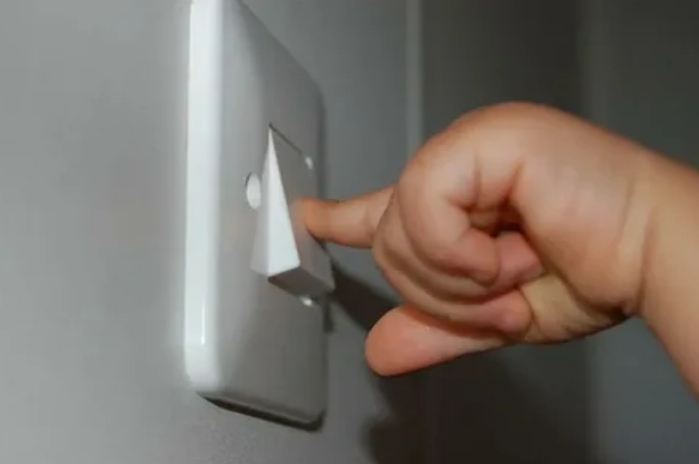
The walk-through model of the switch is a convenient switching device that allows you to turn on and off the luminaire from several places. Such a solution ensures the comfort of operating the lighting equipment.
The use of such devices is advisable in the following situations:
- In the corridor. The two-point connection diagram provides the ability to install one product at the beginning of the corridor, and the second - at the end, which will eliminate the need to go along a dark corridor after disconnecting lamp.
- On the stairs. This is an excellent solution for apartment buildings, private cottages with several floors. Such switches can be located on all or several floors. The user can turn on the light on the site by entering the house, and turn it off before entering the apartment on his floor.
- In the bedroom. The principle of operation does not differ from previous situations, it allows you to turn on the light when entering the room, turn it off at the head of the bed.
The above are the main options for using pass-through switches. In practice, the devices can be installed in any premises, including not only residential, but also technical and industrial ones. This solution provides convenience in light control and reduces energy costs.
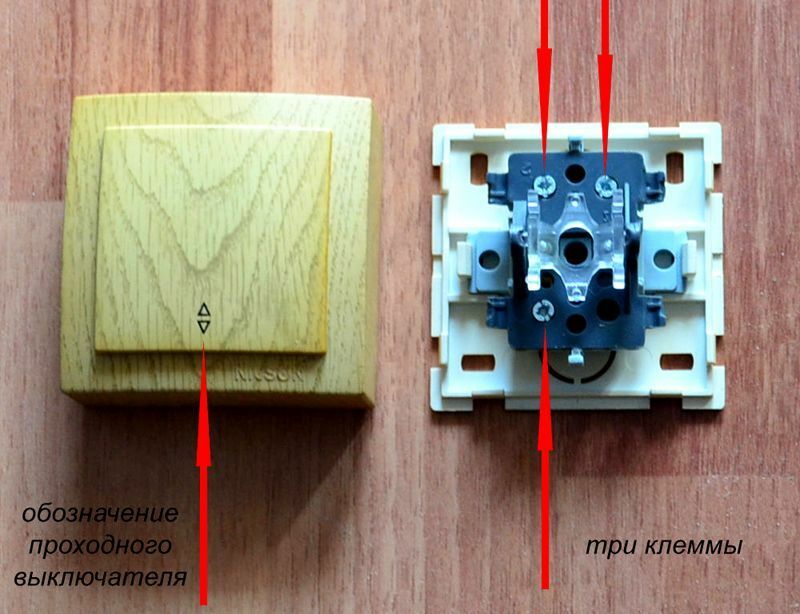
The appearance of the pass-through switch is not much different from the usual one. On its front side there are arrows up and down
The design of a simple switch assumes the presence of one input, one output, while the pass-through has two outputs. Due to this, the flow of current can not only be interrupted, but also redirected. Although experienced electricians are able to determine the type of fixture by external signs, many manufacturers apply a wiring diagram to the product, which simplifies the choice of a switching device.
You can make sure that you are purchasing a single pass-through switch by carefully examining the terminals. There should be three of them. It essentially performs the option of a switch, directing voltage from one contact to another.
To control one lighting device from different points in the room, at least two pass-through switches are used. When the position of the key changes, the circuit is closed, the lamp lights up. When you turn off either of the two switches, the circuit is opened, the lamp goes out. Thus, when the keys of the pass-through switches are in one position, the light is on, when in a different position, it goes out.
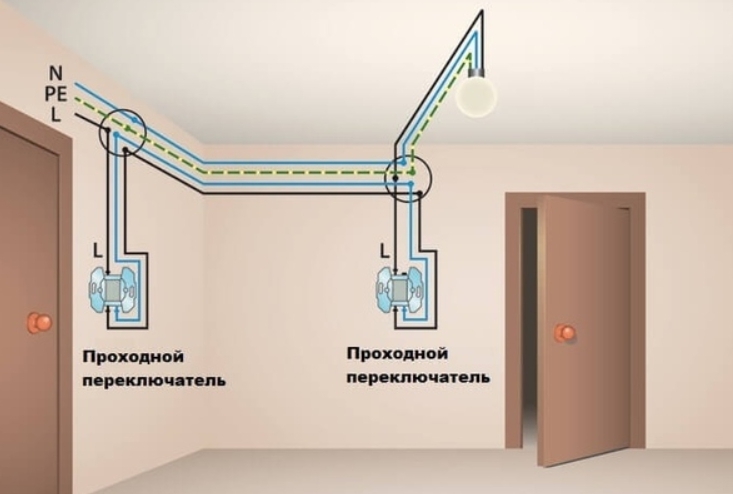
The design features of the pass-through switch eliminate the need to move around a dark room, which reduces injuries, helps to save energy
Using such a switch, it is easy to control lighting from three, four, six points. To do this, it is enough to add the required number of switches to the existing circuit.
Product connection diagram
For convenient control of light from several places, at least two single-key pass-through devices are used, since they work only in pairs. Each of them is equipped with one contact for input, two for output.
As with the installation of any electrical equipment, before installing the pass-through switch, it is necessary to de-energize the power supply section by turning off the power at the switchboard. To make sure that there is no voltage in the wires, you can use an indicator screwdriver. A similar check is carried out at all connection points.
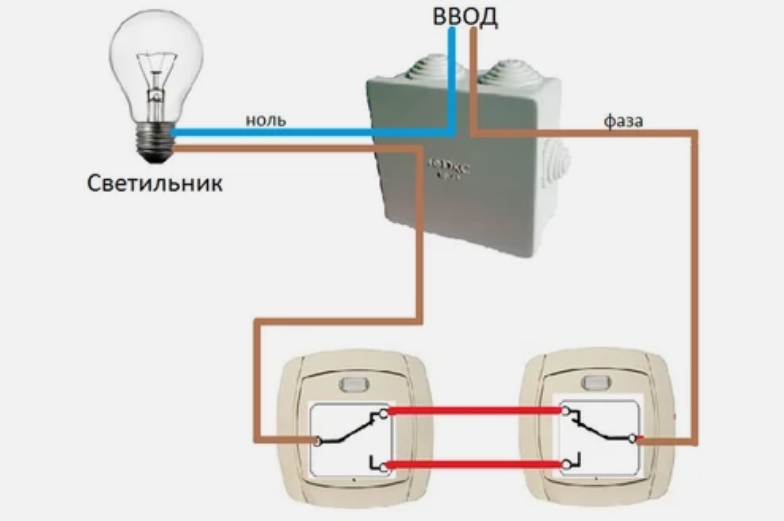
When connecting pass-through switches, at least two products are used. One or more lamps may be present in the circuit, which will be switched on / off at the same time.
When laying concealed wiring for wiring strobes are laid, holes are made for junction boxes and socket boxes in accordance with the layout of the devices.
When planning work, it is important to understand that it will not be possible to simply replace a conventional switch at the checkpoint. It is recommended to lay the wires at a distance of 15 cm from the ceiling. They can not only be pulled in a hidden way, hiding in the grooves, but also laid open way, hide in boxes, trays.
The second method will reduce the labor intensity of work, as well as minimize costs if repairs are necessary. The ends of the cable are led into junction boxes, connected with connectors.
Device installation procedure
All actions carried out during the installation of the pass-through switch are performed in accordance with the connection diagram. It differs from the installation of a standard switch in that three wires are used instead of two. The two wires in this circuit act as a jumper connecting adjacent switches located at different points in the room. The third wire provides the phase supply.
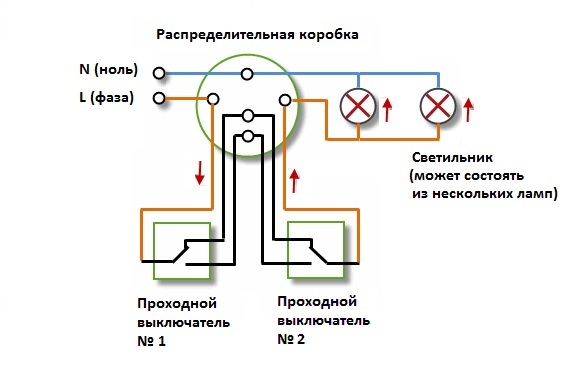
The difference between the connection diagram of the pass-through switch and the wiring diagram of a standard device consists in the presence of three wires, two of which connect the devices, and the third provides power supply
When connecting a pass-through switch, any type of lamp can be used, ranging from a traditional incandescent lamp to modern fluorescent, LED lighting sources.
Five wires will fit into the junction box:
- lighting cable;
- supply wire from the machine;
- wire from the second pass-through switch.
To ensure a long service life of electrical wiring, it is recommended to correctly choose cable cross-section for home wiring.
To build a circuit with two one-button switches, a three-core cable is used. In this case, grounding, "zero" is displayed on the light source. And the phase highlighted in brown in the diagram provides power. It goes through both the switch and the lamp.
Since these switches are located in the break in the phase cable, the safety of work during the repair, maintenance of the lighting fixture is ensured.
Work on connecting a one-button switch (pass-through) is carried out in the following sequence:
- release from isolation ends of wires;
- using the indicator, find the phase wire and zero;
- lay the neutral wire from the machine through the junction box to the chandelier / lamp.
- connect the phase of the supply wire that passed through the junction box to the input contact of the first switch;
- connect (through the junction box) two output contacts of one pass-through switch with two output contacts of the other;
- it remains to connect the phase going (through the junction box) to the chandelier / lamp to the output contact of the second switch.
The joints can be twisted, soldered and wrapped with electrical tape. Or use self-clamping terminal blocks.
We have considered other methods and rules for high-quality and correct connection of wires in this article.
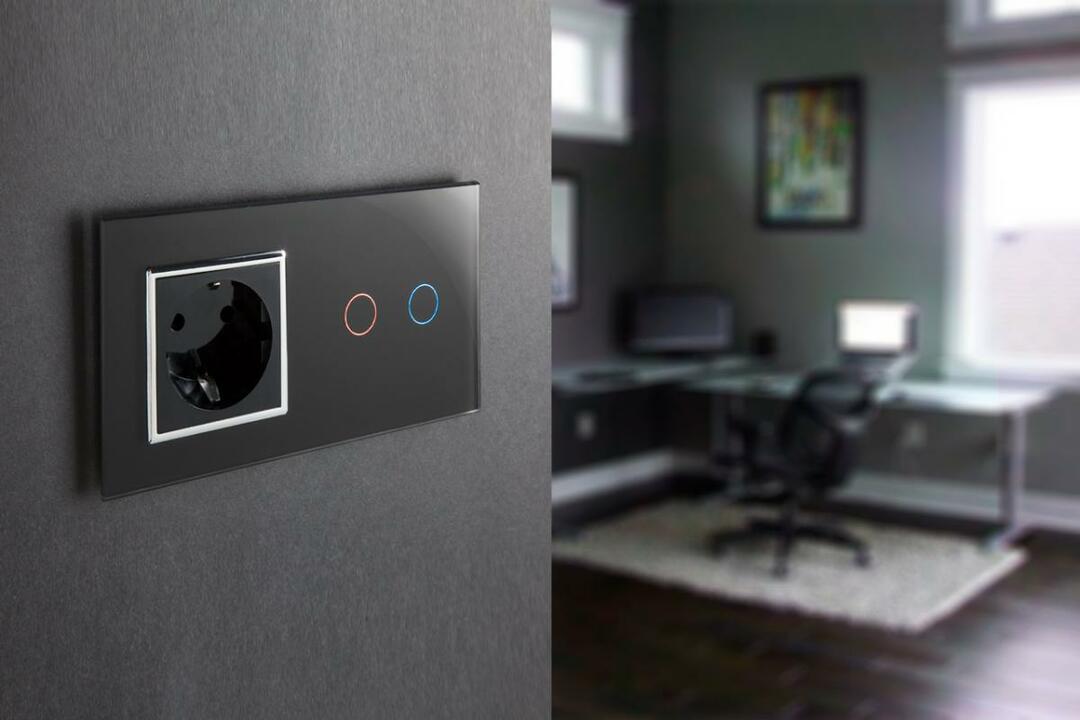
In apartments, private cottages, not one, but two-key pass-through switches are often used. Fixtures with two keys allow you to control two lighting fixtures, which are located in different rooms
In addition to keyboards, manufacturers offer touchpads. However, when installing them, you cannot do without professional help.
If it is necessary to control lighting from more than two points, up to six pass-through switches can be used in the circuit. In our other article, we went through the nuances step by step pass-through switch connections from two and three places, providing the material with visual diagrams.
Conclusions and useful video on the topic
Having a walk-through switch connection diagram, basic experience in performing electrical work, you can upgrade your home lighting control system yourself.
The video below will help you understand the differences between a conventional and a pass-through switch, and determine the order of installation work:
This video will help you connect pass-through switches without using a junction box:
This video will help you provide lighting control from three or more locations.
The possibility of increasing the comfort of living, combined with a decrease in energy costs, is of interest to many, therefore, the use of walk-through switches is becoming more and more popular among owners of spacious apartments, private cottages.
If you have experience in installing such switching equipment on your own, share your achievements with other visitors to our site. If you are just looking at such a solution, you have questions, ask our experts in the block below.


